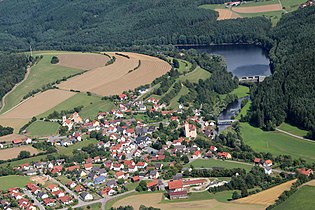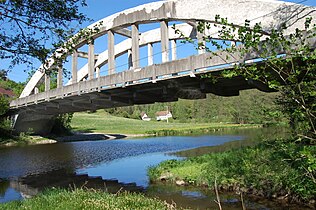Kaltenthal (Trausnitz)
|
Kaltenthal
municipality Trausnitz
Coordinates: 49 ° 30 ′ 55 ″ N , 12 ° 15 ′ 31 ″ E
|
||
|---|---|---|
| Height : | 395 m | |
| Postal code : | 92555 | |
| Area code : | 09655 | |
|
Location of Kaltenthal in Bavaria |
||
|
Kaltenthal (2016)
|
||
Kaltenthal is part of the Trausnitz community in the Schwandorf district .
geography
Kaltenthal is located in the middle Upper Palatinate Forest on the Pfreimd river , around 500 m southwest of the village of Trausnitz at an altitude of 395 meters on the state road 2157, which leads from Trausnitz to Pfreimd .
history
In 1326 the Urbarium named Vicedominatus Lengenveld Chaltental (= Kaltenthal), Choeteltz (= Köttlitz) and Saechsenchirchen (= Sächsenkirchen, the former place name of today's Trausnitz) belonging to the administrative center of Trausniht (name of Trausnitz Castle). In 1538 Jobst Wolf Erlbeck held the Trausnitz manor. He died in 1558 without an heir, so that Kaltenthal fell back to the feudal lord. On October 18, 1563, "Hans Christoph von Giech zu Wiesentfels, ... with the fiefs of Eschldorf, Rötenbach, Kaltenthal and Gutenfürst which had fallen back from Jobst Wolf Erlbeck" was enfeoffed against payment of 3,000 guilders.
Hammer Kaltenthal
In the Middle Ages, mills, small cutting saws and hammer mills were built along the watercourses that made use of the power of water. There was enough wood available in the area around the Pfreimd for the hammer mills. In 1846 the district court of Nabburg, to which Kaltenthal belonged, was part of the Eisen- und Hammergau Upper Palatinate. In 1519 Kaspar Erlbeck bought the Trausnitz estate and other goods from the Zengers. The Hammer Kaltenthal with the hammer master Ulrich Seus belonged to Trausnitz. Due to financial problems of Erlbeck, the hammer went to the Margraves Casimir and Georg von Brandenburg. Jobst Wolf Erlbeck followed in 1538, and Hans Christoph von Giech in 1563. On April 15, 1576, his sons Hans Christoph and Georg Dietrich von Giech followed as owners of the Kaltenthal hammer. On September 19, 1592, ownership of the Hammer Kaltenthal, the team on the Hammer and four farms to "Guttenvirst" passed to Hans Sazenhofen von Fuchsberg . After the death of Hans von Sazenhofen, his sons Veit Hans, Christoph Philipp, Jobst Sigismund and Georg Peter took over the inheritance, which they sold to Hans von Brandt auf Stein in 1605. On January 14, 1605, Hans von Brandt ceded the property to Thomas von Sparneck. His son Hans Ludwig von Sparneck took over the hammer. After the death of his father Thomas von Sparneck, Hans Ludwig von Sparneck received the hammer, which passed to Hans Adam von Sparneck-Weißdorf on November 6, 1616. In 1621 the Thirty Years' War reached the Upper Palatinate, with devastating economic, social and cultural effects, even for many hammers. On November 5, 1658, Hans Georg Otto, Hans Christoph Erdmann von Sparneck and their brother Hans Wilhelm Ernst, who lived abroad, were enfeoffed with the Kaltenthal hammer that Hans Georg Otto ran. On May 19, 1681, Hans Christoph Ernst and Wolf Adam Bernhard von Sparneck-Weißdorf received the Hammer Kaltenthal. Since Wolf Adam Bernhard von Sparneck left no heirs, the property fell to his two sisters Maria Salome Katharina, married to Johann Bernhard von Donndorf on Ramlesreut near Stadtkemnath and to Maria Sophia Johanna, the wife of Johann Georg Lochner von Hüttenbach on Lintach. Maria Salome Katharina von Donndorf moved with her husband to Trausnitz to manage the estate. Half of the profit was to be given to her sister Maria Sophia Johanna von Lochner. You should also contribute to the costs. The sisters quarreled, which led to the sale of Trausnitz and Kaltenthal. On June 12, 1714, Baron von Quentel, keeper of Schwandorf, acquired the estate. With this sale Maria Salome Katharina von Donndorf had stipulated 300 guilders for the eternal light in Trausnitz. In 1763 the estate was bought by Johann Balthasar von Hannakam through an auction.
Tax District and Parish Education
The Kingdom of Bavaria was divided into 15 districts in 1808. These districts were named after rivers based on the French model ( Naabkreis , Regenkreis , Unterdonaukreis , etc.). The districts were divided into district courts. In 1811 the district court of Nabburg was divided into 58 tax districts. One of them was Trausnitz, “consisting of the villages of Trausnitz with that of Kargschen Castle and Köttlitz, the deserted areas of Kaltenthal and Ödmühl, the manorial forest of Stein, called the Sölzer and Kotlitzer Dikigt, the manorial forest of Hohentreswitz, called the water wood, as well as the Anzerholz ”. The districts in turn should be divided into individual municipality areas. In 1828 the hamlets and solitary areas of Atzenhof , Bierlhof (= Unterbierlhof), Kaltenthal, Oberpierlhof , Ödmühl, Reisach, Schweizerbach and Trausnitz belonged to the Trausnitz community.
photos
literature
- Johann Baptist Schütz, chronicle of the royal Bavarian castle Trausnitz im Thal, published for the best of the construction of the historical parish church Trausnitz, Trausnitz im Thal 1890
- Monumenta Boica, 36
- Amberg State Archives, Rent Office No. 834
- Wilhelm Blab, Economic division of the Upper Palatinate 100 years ago, The Upper Palatinate, Kallmünz 1959
- Elisabeth Müller-Luckner, Historical Atlas of Bavaria, part of Old Bavaria, issue 50, Nabburg, Munich 1981, ISBN 3-7696-9915-7
- Ernst Emmering, The Government of the Upper Palatinate, History of a Bavarian Central Authority, Contributions to the History and Regional Studies of the Upper Palatinate, Issue 20, Regensburg 1981
Web links
Individual evidence
- ↑ Monumenta Boica, 36 / I, p. 617
- ↑ Elisabeth Müller-Luckner, Historical Atlas of Bavaria, part of Old Bavaria, issue 50, Nabburg, p. 246 f.
- ^ Johann Baptist Schütz, Chronicle of the Royal Bavarian Castle Trausnitz im Thal, p. 82
- ^ Wilhelm Blab, Economic division of the Upper Palatinate 100 years ago, The Upper Palatinate, 1959, p. 33 f.
- ^ Elisabeth Müller-Luckner, Historical Atlas of Bavaria, part of Old Bavaria, issue 50, Nabburg, p. 256
- ^ Johann Baptist Schütz, Chronicle of the Royal Bavarian Castle Trausnitz im Thal, p. 82
- ^ Johann Baptist Schütz, Chronicle of the royal Bavarian castle Trausnitz im Thal, p. 86
- ↑ Johann Baptist Schütz, Chronicle of the Royal Bavarian Castle Trausnitz im Thal, p. 92
- ↑ Johann Baptist Schütz, Chronicle of the royal Bavarian castle Trausnitz im Thal, p. 106
- ↑ Johann Baptist Schütz, Chronicle of the royal Bavarian castle Trausnitz im Thal, p. 107
- ^ Emmering, Ernst, The Government of the Upper Palatinate, History of a Bavarian Central Authority, Contributions to the History and Regional Studies of the Upper Palatinate, Issue 20, Regensburg 1981, p. 12 ff.
- ^ Elisabeth Müller-Luckner, Historical Atlas of Bavaria, part of Altbayern, issue 50, Nabburg, p. 402
- ^ Elisabeth Müller-Luckner, Historical Atlas of Bavaria, part of Old Bavaria, issue 50, Nabburg, p. 430.








